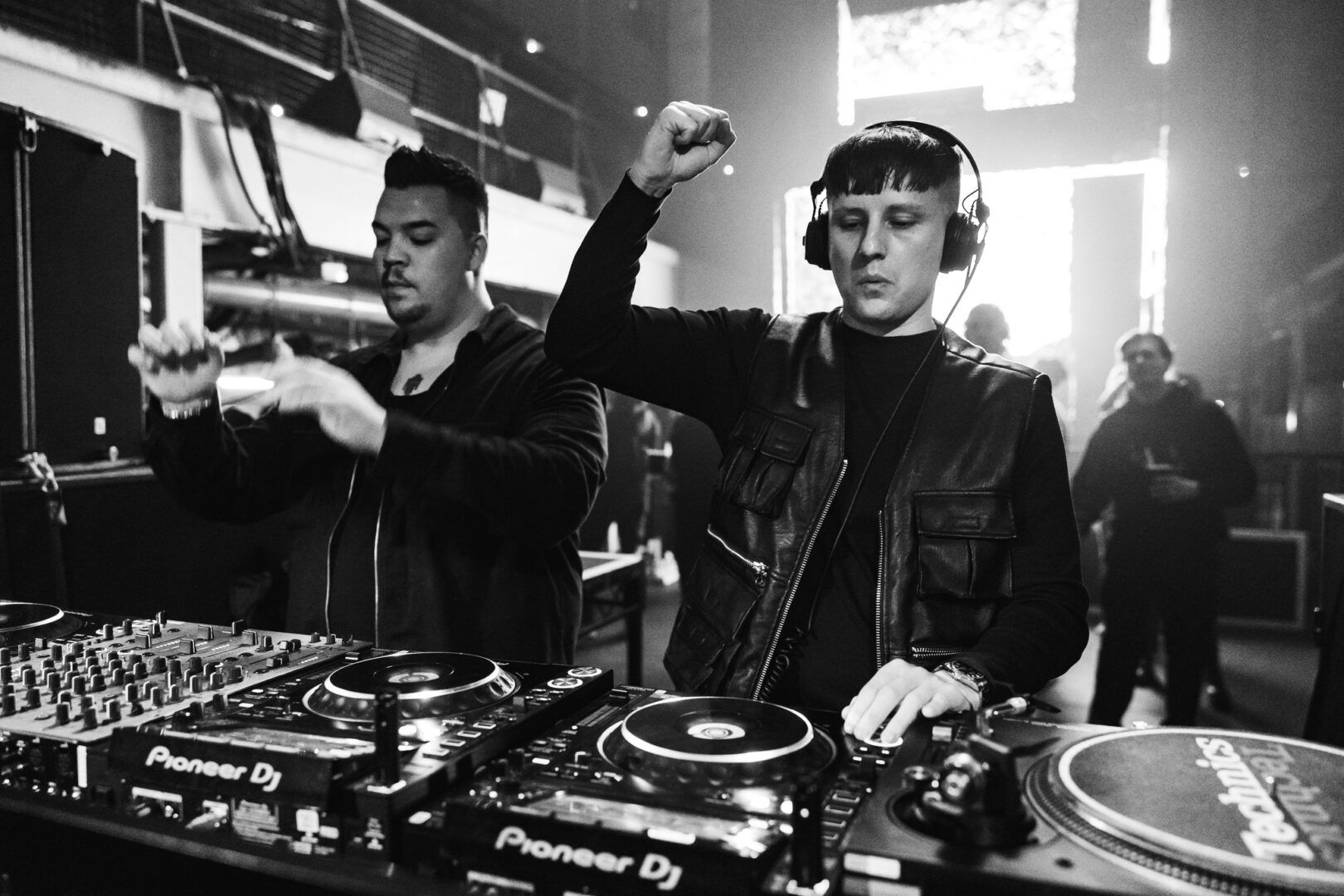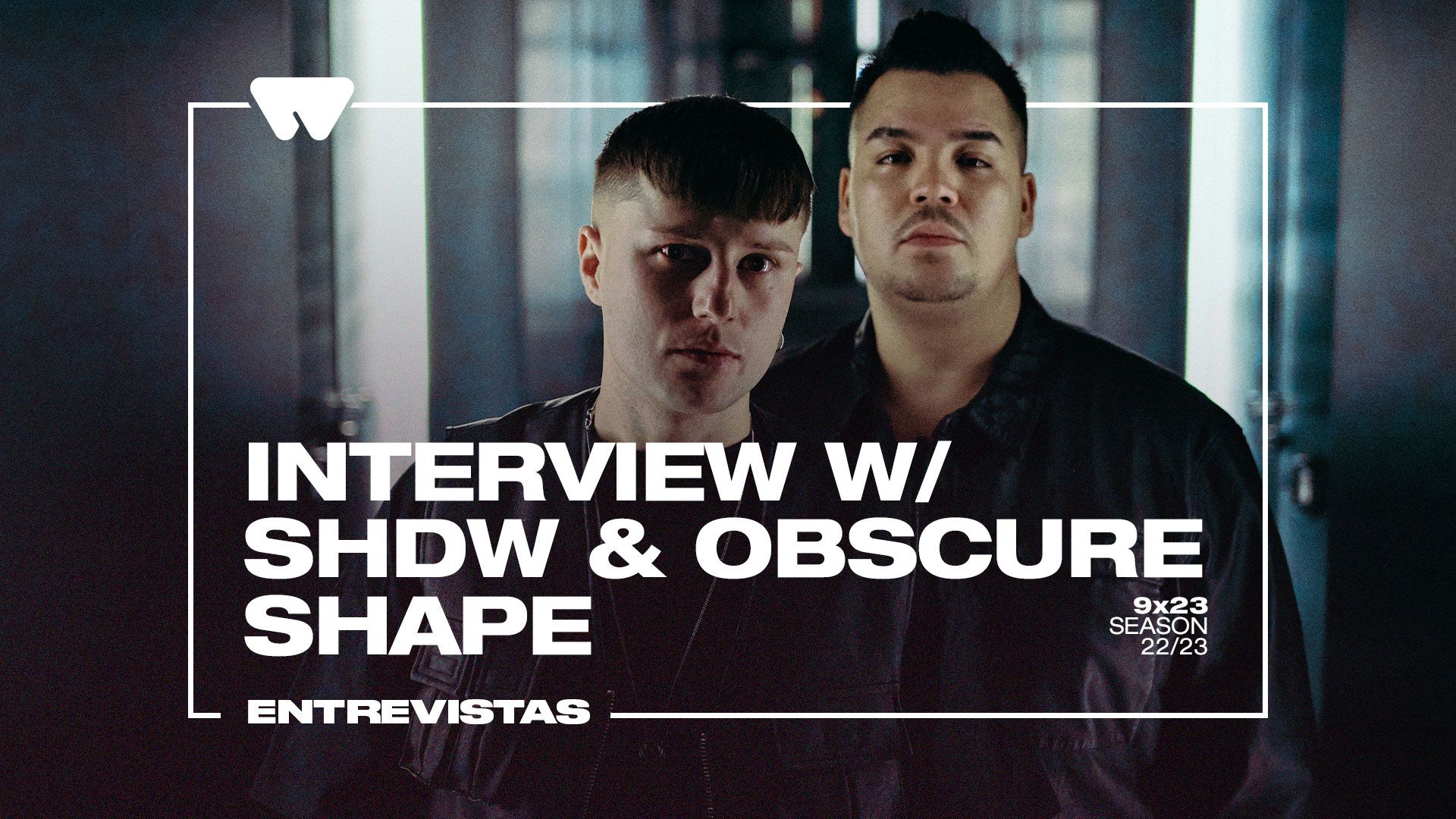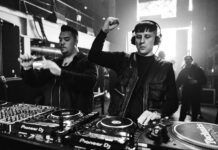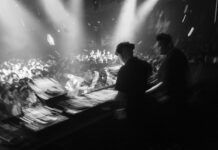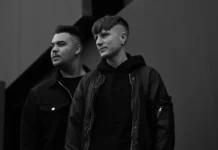En la entrevista de hoy hablamos con uno de los dúos más destacados de la escena actual. Los alemanes Marco y Luigi, más conocidos como SHDW & Obscure Shape, se han convertido en una pieza clave del circuito techno, comandando los sellos From Another Mind y el reciente Mutual Rytm, con este último dando un giro a su faceta musical hacia un enfoque más clásico y dirigido a la pista de baile. Vamos con la entrevista.
Wololo Sound: Comenzasteis vuestro proyecto conjunto en 2014. ¿Cuál era vuestro vínculo? ¿Cómo empezasteis a trabajar juntos?
SHDW & Obscure Shape: ¡Hola, muchas gracias por la invitación!. Un círculo de amigos similares y nuestro amor común por la música electrónica nos unió alrededor del 2008. Al principio no mantuvimos una amistad cercana ni trabajamos juntos, sino que simplemente hablamos sobre música y la comunidad techno, ya que a menudo visitábamos los mismos clubes y pinchábamos en las mismas fiestas de vez en cuando. En el otoño de 2014, entramos juntos al estudio por primera vez, completamente sin intenciones, sino solo por el amor a la música. Pero ya en la primera sesión en el estudio nació nuestra primera canción conjunta ‘Nur Die Sonne War Zeuge’, que luego lanzamos en nuestro primer EP ‘Nachtblende’. Rápidamente nos dimos cuenta de que la sinergia entre nosotros era muy especial, por lo que terminamos pichando juntos por primera vez en la primavera de 2015. Sin embargo, no planeamos que actuáramos como dúo, esto sucedió por sí solo con el tiempo junto con los primeros lanzamientos.
Wololo Sound: You started your common project back in 2014. Which was your link? How did you start working together?
SHDW & Obscure Shape: Hi, thank you very much for the invitation and it’s a pleasure to meet you. A similar circle of friends and our common love for electronic music brought us together around 2008. At the beginning we didn’t really maintain an intimate friendship or work together, but we just talked about music and the techno community, as we often visited the same clubs and played at the same parties from time to time. In the fall of 2014, we actually went into the studio together for the first time, completely with no intentions, but just for the joy of music. But already in the first studio session our first joint track ‘Nur Die Sonne War Zeuge’ was born, which we later released on our debut EP ‘Nachtblende’. We quickly realized that the collaboration between us is something very special, which is why we then actually ended up working together behind the decks for the first time in the spring of 2015. Nevertheless, it was not initially planned that we perform as a DJ duo together. This then came about by itself with time and the first releases.
WS: Nacisteis en Alemania, un país fuertemente relacionado con la cultura techno. ¿Cuáles fueron las principales influencias que os introdujeron a este estilo? ¿Cómo os enamorasteis de la música electrónica?
SHDW & OS: Nuestra preferencia por el techno se ha desarrollado con el tiempo. A través de nuestro círculo de amigos, empezamos a ir de fiesta muy temprano, es decir, ya en el comienzo de nuestra adolescencia nos encontramos con la música electrónica de baile. En ese momento aún podrías entrar a clubes con carnets de estudiante falsos. Todo empezó con el house y el electro, luego nos enfocamos bastante rápido, alrededor de 2007, en dirección al techno minimalista, que era bastante popular en el sur de Alemania en ese momento. Debido a la moda en torno al nuevo sonido CLR en 2010, nos metimos de lleno en el techno. Desde entonces nos hemos sentido muy cómodos en este estiloo porque es muy versátil, abierto y profundo. Son valores con los que siempre nos hemos identificado muy bien.
WS: You were born in Germany, a country that is strongly connected to techno culture. Which were the main influences that introduced you to the genre? How did you fall in love with electronic music?
SHDW & OS: Our preference for techno has developed over time. Through our circle of friends, we went partying really early, that is, already in our early teenage years we came across electronic dance music. At that time you could still go dancing in clubs with fake student IDs. It started with house and electro, which then developed pretty quickly around 2007 in the direction of minimal techno, which was pretty popular in southern Germany at that time. Due to the hype around the new CLR sound in 2010, we really got into techno. Since then we felt very comfortable in this genre because it is very versatile, open-hearted and deep. Values with which we could always identify ourselves very well.
WS: Desde vuestro comienzo, habéis pasado por diferentes estilos y habés creado dos sellos discográficos. ¿Cómo surgió Mutual Rytm? ¿En qué se diferencia de vuestro sello anterior, From Another Mind?
SHDW & OS: Queríamos empezar un segundo sello discográfico desde hace mucho tiempo. Sin embargo, no queríamos apresurarnos y darle tiempo a la planificación hasta que hubiésemos definido un concepto y una estrategia para esto, porque éramos conscientes desde el principio de que este proyecto traería muchos nuevos desafíos y responsabilidades. Durante la pandemia, finalmente encontramos el tiempo para dedicarnos a esto y poder implementar nuestros planes.
Una de las motivaciones más importantes para este segundo sello discográfico era crear un lugar para que otros artistas pudieran lanzar su música y poder desarrollarse libremente. Con Mutual Rytm tenemos la posibilidad de acompañar, especialmente a artistas jóvenes, en su desarrollo musical y apoyarlos. Así que finalmente podemos aportar algo con nuestra experiencia y alcance, lo cual es muy importante para nosotros. Al mismo tiempo, nuestro nuevo sello también sirve como una base para nuestra dirección musical y artística.
Mutual Rytm difiere de muchas maneras de From Another Mind. La música es mucho más atemporal y se enfoca más en el ritmo o el groove. Como resultado, las pistas son generalmente más útiles y aptas para pinchar. From Another Mind está más asociado con nuestros “himnos de club de hora punta”. El concepto visual de Mutual Rytm también, al igual que la música en sí, es mucho más minimalista y atemporal que From Another Mind.
WS: Since the beginning, you have gone through different styles and you have created two labels. How did Mutual Rytm emerge? How is it different from your previous label, From Another Mind?
SHDW & OS: We wanted to start a second record label for a long time. However, we didn’t want to rush and give the planning time until we have defined a clear concept and strategy for this, because we were aware from the beginning that this project will bring many new challenges and responsibilities. During the global pandemic, we finally found the time to dedicate to this and to be able to implement our plans.
One of the most important motivations for a second label was to provide a platform for other artists to release their music on it and to be able to develop themselves freely. With Mutual Rytm we have the possibility to accompany the, especially young, artists in their further musical development and to support them. So we can finally give something back with our experience and our reach, which is very important to us. At the same time, our new label also serves as a foundation for our musical and artistic direction.
Mutual Rytm differs in many ways from From Another Mind. The music is much more timeless and focuses more on the rhythm or groove. As a result, the tracks are generally more functional and DJ-friendly. From Another Mind is more associated with our “Peak Time Club Anthems”. The visual concept of Mutual Rytm is also, like the music itself, much more minimalistic and timeless than From Another Mind.
WS: Sin duda, la creación de Mutual Rytm es una de las novedades más destacadas del año pasado, tanto para vosotros como para la escena techno. ¿Cómo lleváis el trabajo como selectores en vuestro propio sello? ¿Qué es esencial en un artista o en una canción para llamar vuestra atención?
SHDW & OS: El trabajo como managers de un sello discográfico suele ser muy divertido para nosotros, aunque hayamos subestimado completamente la cantidad de trabajo y tiempo requeridos para esto, al menos teniendo en cuenta nuestro tiempo productivo actual. Sin embargo, nunca querremos dejar estos nuevos desafíos y la responsabilidad que conlleva en manos de otra persona, porque el contacto cercano y directo con los artistas es muy importante para nosotros. La creación de un lanzamiento junto con el artista es increíblemente emocionante. Además, la búsqueda de productores nuevos y establecidos nunca será aburrida, porque de alguna manera también es muy inspiradora y motivadora.
Es importante para nosotros que la música suene innovadora y original. A menudo hablamos de un “sonido distintivo”, que es único y habla desde el alma de un artista, un paisaje sonoro distintivo. La música debe sonar como él o ella y no como una simple copia o una pista basada en puro sampleo.
No es fácil crear un sonido tan reconocible y distintivo. Pero eso no es todo, porque por supuesto la música también tiene que captar nuestra atención y evocar emociones en nosotros cuando la escuchamos para que tengamos ganas de escuchar más.
WS: Undoubtedly, the creation of Mutual Rytm is one of the most remarkables novelties of last year, both for you and for the techno scene. How do you face your work as selectors of your own label? What is essential in an artist or a track in order to catch your attention?
SHDW & OS: The work as a label manager is generally a lot of fun for us, even if we have completely underestimated the amount of work and time required for this, at least at our current output level. Nevertheless, we will never want to leave these new challenges and the responsibility that comes with them in the hands of someone else, because close and direct contact with the artists is very important to us. Putting together a release together with the artist is incredibly exciting. Also, the search for new and established producers will never be boring, because this is also somehow very inspiring and motivating in its own way.
It’s important to us that the music sounds innovative and original. We often talk about a “signature sound”, which is unique and speaks from the soul of an artist, a distinctive sound scape. The music must sound like him or her and not like a simple copy or a too-sampling-based track.
It is not easy to create such a strong recognizable sound. But that’s not all, because of course the music must catch our fancy and evoke emotions in us when we listen to it so that we are eager for more.
WS: Como hemos señalado antes, habéis tomado una nueva dirección y vuestros sets durante este año son una muestra de ello, con un estilo que se ha vuelto más enérgico y brillante, trayendo de vuelta clásicos del techno como ‘Latin Lovers’ o ‘Street Carnival’. ¿Cuál es la razón de este cambio en vuestra línea musical?
SHDW & OS: En 2019 ya nos dimos cuenta de que el sonido que estábamos pinchando en ese momento ya no salía del alma. Fue el momento en que el techno se volvió más rápido, más duro y de alguna manera más aburrido de nuevo. Al principio, nos dejamos seducir parcialmente por la tendencia, porque el cambio siempre es interesante y siempre estamos abiertos a cosas nuevas. Cuando el mundo se paralizó por completo en marzo de 2020, nos sumergimos en las raíces de nuestra música y aprovechamos el tiempo para reflexionar sobre nosotros mismos y los últimos años de nuestra carrera. Rápidamente nos dimos cuenta de que algo tenía que cambiar y que teníamos que tomar nuevos caminos para encontrarnos completamente de nuevo. Comenzamos con un nuevo estudio de música y con ello nuevos enfoques a la hora de producir y, por supuesto, la creación de nuestro sello discográfico Mutual Rytm. La música que lanzamos y pinchamos hasta entonces siempre se inspiró en el techno clásico de finales de los 90 y principios de los 2000. Por lo tanto, fue bastante fácil para nosotros hacer el cambio, ya que la mayoría de nuestra colección de música ya representaba este sonido. Muchas de las pistas que solíamos usar las volvemos a pinchar en nuestros sets hoy en día, pero un poco más rápidas, por supuesto.
WS: As we have pointed before, you have taken a new direction and your sets during this year prove that your style has become more energetic and bright, bringing back classic techno tunes like ‘Latin Lovers’ or ‘Street Carnival’. What is the reason for this change in your musical line?
SHDW & OS: We have already noticed in 2019 that the sound that we played at this point in time, no longer spoke from the soul. This was the time when techno became faster, harder as well as somehow duller again. In the beginning, we were partially seduced by the trend, because change is always interesting and we are always open to new things. When the world came to a complete standstill in March 2020, we dived deep into the roots of our music and used the time out to reflect on ourselves and the last years of our career. Here we quickly realized that something had to change and we had to take new paths to be able to fully find ourselves again. It started with a new music studio, new approaches to making music and of course the creation of our label Mutual Rytm. The music we released and played until then was always inspired by classic techno from the late 90s and early 2000s. Therefore, it was quite easy for us to make the change, as the majority of our music collection already represented this sound. A lot of tracks we used to play, we play again in our sets nowadays, but a bit faster of course.
WS: En solo unos pocos años hemos visto cómo muchos artistas en la escena se centraron en géneros como hardcore o trance porque se volvieron populares en ese momento. Hoy en día, estamos notando que hay muchos otros artistas enfocándose en sonidos old school también. ¿Crees que ha surgido una nueva ola en la escena techno europea? ¿Será esto otra tendencia temporal?
SHDW & OS: Sí, hay, afortunadamente, cada vez más artistas y sellos discográficos que se enfocan en el sonido clásico y atemporal del techno. No cabe duda de que este sonido está de nuevo en auge. Pero este nunca ha estado realmente “ausente” de la escena y nunca lo estará, porque este es el origen de la verdadera música techno. Siempre hay altibajos en un género ya establecido. Las modas, como la tendencia del “Tik Tok Techno” creada durante la pandemia o la tendencia del “Dark Techno” hace 5 años, vendrán y se irán.
WS: In just a few years we saw that many artists in the scene started to focus on genres like hardcore or trance because they became trendy at that time. Nowadays, we are noticing that there are many other artists focusing on old school sounds as well. Do you think that a new wave has emerged in the European techno scene? Will this be another temporary trend?
SHDW & OS: Yes, there are, fortunately, more and more artists and labels that focus on the classic and timeless techno sound. The fact that this sound is currently on the rise again can definitely be heard. But this sound has never really been “gone” from the scene and never will be because this is the origin of true techno music. There are always various highs and lows of an already well established genre. Hypes, like the “Tik Tok Techno” trend created during the pandemic or “Dark Techno” trend 5 years ago, will come and go.
WS: Siguiendo la pregunta anterior, reconocemos que un número creciente de personas se inician en la escena techno sin conocimientos previos sobre el género ni su cultura. ¿Crees que en ciertos lugares la escena se está corrompiendo de alguna manera?
SHDW & OS: La pregunta de si la tendencia actual está afectando la ideología del techno es algo que nos hemos preguntado a menudo. No creemos que vaya a destruir la escena, pero definitivamente está cambiando. Por supuesto, es agradable ver que cada vez más personas disfrutan de la música electrónica de baile. Pero, como mencionamos anteriormente, es muy preocupante que la mayoría de la nueva generación no sepa nada sobre la historia del techno, cuál es su origen y quiénes son sus fundadores. Para muchos, “techno” comienza solo a partir de 150BPM y más, y una pista de “techno real” incluye letras catchy, en el mejor de los casos de un éxito en las listas, y sonidos típicos de rave. ¿Jeff quién? En nuestra opinión, la tendencia actual no debería ser llamada techno y la cultura techno debería ser traída de vuelta al primer plano mediante una clara separación de géneros. Por último, pero no menos importante, tratamos de hacer eso con nuestro sello Mutual Rytm, para traer de vuelta el verdadero sonido a la vida.
WS: Following the previous question, we recognize that an increasing number of people start out in the techno scene without any previous knowledge about neither the genre nor its culture. Do you think that in certain places the scene is becoming corrupted somehow?
SHDW & OS: The question of whether the current trend is affecting the ideology of techno is one we’ve often asked ourselves. We don’t think it will destroy the scene, but it’s definitely changing. Of course, it’s nice to see that more and more people are enjoying electronic dance music. But as mentioned above, it’s very scary that most of the new generation doesn’t know at all about the history of techno, what its origin is and who its founders are. For many, “techno” only starts at 150BPM and above, and a “real techno” track includes catchy lyrics, at best still from a chart hit, and typical rave sounds. Jeff who? In our opinion, the current trend should not be called techno and the techno culture should be brought back to the foreground by a clear genre separation. Last but not least we try to do that with our label Mutual Rytm, to bring the true sound back to life.
WS: ¿Cómo son sus días de trabajo como dúo? ¿Cómo equilibran un calendario de giras tan ocupado y su trabajo en el estudio y la gestión de su sello discográfico?
SHDW & OS: Desafortunadamente, vivimos a casi una hora de distancia el uno del otro, por lo que tenemos que planificar con anticipación nuestro tiempo juntos en el estudio. En los días en que no producimos juntos, seguimos trabajando en nuestros proyectos juntos, aunque la mayoría de las veces cada uno asume una tarea diferente. Esa es la gran ventaja de ser un dúo, cada uno tiene sus propias fortalezas y debilidades, por lo que terminamos complementándonos muy bien de muchas maneras y el efecto de sinergia resultante es muy fuerte. Afortunadamente, podemos organizar nuestro día de trabajo nosotros mismos y, por supuesto, la cantidad de trabajo depende de qué proyectos y plazos estén pendientes en ese momento. A pesar de todo el trabajo, también intentamos dedicar suficiente tiempo a nuestros amigos y familiares, y por supuesto a nosotros mismos. Además, también es importante para nosotros tomarnos un breve descanso creativo de vez en cuando y programar nuestra agenda de giras de la mejor manera posible.
WS: How do your work days as a duo look like? How do you balance such a busy tour calendar and your job in the studio as well as running your label?
SHDW & OS: Unfortunately, we live almost an hour’s drive away from each other, so we have to plan our time together in the studio in advance. On the days when we’re not producing together, we still work on our projects together, even though most of the time everyone takes on a different task. That’s the great thing about being a duo, everyone has their own strengths and weaknesses, which is why we end up complementing each other so well in many ways and the resulting synergy effect is therefore very strong. Fortunately, we can organize our workday ourselves and, of course, the amount of work depends on which projects and deadlines are pending at the moment. Despite all the work, we also try to take enough time for our friends and family, and of course ourselves. In addition, it is also important for us to take a short creative break every now and then and to set up our tour schedule as best as possible
WS: ¿Qué esperáis de este año? ¿Qué proyectos tenéis por delante? ¿Podríais adelantarnos alguna sorpresa de lo que se aproxima?
SHDW & OS: 2023 será el año más productivo de nuestra carrera. Tenemos planeado un emocionante lanzamiento de vinilo de 12″ cada mes en Mutual Rytm y se acercan las primeras noches del sello alrededor del mundo, incluyendo Madrid. Como artistas, ya lanzamos nuestro primer EP ‘Vergessene Welt’ en From Another Mind en enero, el segundo en Mutual Rytm llegará en abril y al menos llegará otro más, así como varios remixes y podcasts, que están programados para este año. Pero lo más importante en 2023 será nuestro primer propio festival de From Another Mind en Karlsruhe este verano. Por último, pero no menos importante, queremos finalmente trabajar en nuestro primer acto en vivo y álbum debut, pero queremos tomarnos nuestro tiempo para ello y no ponernos bajo presión.
WS: What’s your assessment of this year? Which projects do you have ahead? Could you anticipate us any surprise over the rest of the year?
SHDW & OS: 2023 will be the most productive year of our career. We have a new exciting 12″ vinyl release planned every month on Mutual Rytm and the first label nights around the world are coming up, including Madrid. We as artists have already released our first EP ‘Vergessene Welt’ on From Another Mind in January, the second one on Mutual Rytm will follow in April and at least one more full length release, as well as various remixes and podcasts, are still scheduled for this year. But the biggest milestone in 2023 will be our first own From Another Mind Festival in Karlsruhe this summer. Last but not least, we want to finally work on our first live act and debut album, but we want to take our time here and not put ourselves under pressure.
WS: El año pasado visitasteis nuestro país cuatro veces (Madrid, Monegros, Ibiza y Granada) y estos shows fueron increíbles para el público español. ¿Cómo os sentís cuando actuáis en España?
SHDW & OS: Nos encanta pinchar en España porque siempre nos sentimos muy bienvenidos y apreciados allí. El público siempre está lleno de energía, es abierto a cosas nuevas y en general es muy entusiasta en comparación con otros países de Europa. Realmente se puede sentir el calor en la multitud, lo que hace que los shows allí sean muy especiales. Por supuesto, también nos gusta mucho la comida y el clima mediterráneo.
WS: Last year you have visited our country four times (Madrid, Monegros, Ibiza and Granada) and these shows ave been amazing for the Spanish audience. How do you feel when you perform in Spain?
SHDW & OS: We love playing in Spain because we always feel very welcomed and appreciated there. The audience is always full of energy, is open to new things and is generally very enthusiastic compared to other countries in Europe. You can really feel the fire in the crowd, which makes the gigs there very special. Of course, we also like the Mediterranean food and climate very much.
WS: Y para terminar, vamos con algunas preguntas cortas:
¿Un tema de cierre que nunca falla?: CJ Bolland – Camargue
¿El último vinilo que hayáis comprado: Fireground – Recreation [IT055]
¿Un artista no electrónico (o banda)?: Rammstein
¿Vuestro mejor show hasta la fecha?: Es imposible elegir sólo uno, ¡lo siento chicos!
¿Un hobby del que disfrutar en vuestro tiempo libre?: Naturaleza y buena comida.
WS: And finally, let’s go with some quick questions
A closing track that never fails: CJ Bolland – Camargue
The last vinyl that you have purchased: Fireground – Recreation [IT055]
A non electronic artist (or band): Rammstein
Your best show to date: It’s impossible to choose one show, sorry guys!
A hobby you enjoy to relax during your free time: Nature & good food.
